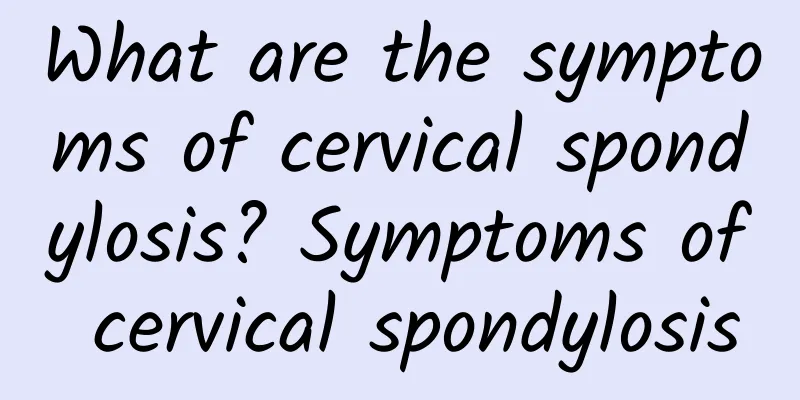What are the symptoms of cervical spondylosis? Symptoms of cervical spondylosis

|
Before, cervical spondylosis was exclusive to the elderly. At present, with the increasing pressure of life and work, the patients suffering from this disease are getting younger and younger, even college graduates. So what are the symptoms of this disease? 1. Sympathetic nervous system symptoms: blurred vision, weak eyelids, swollen and painful eye sockets, tearing; tachycardia or bradycardia, precordial pain and high blood pressure, cold limbs, and decreased body temperature. When exposed to cold, the limbs may feel a tingling sensation, followed by redness, swelling, or increased pain; the head, face, and neck may also feel numbness or pain, and there may be tinnitus, deafness, and numbness of the tongue. 2. Vertebral artery type symptoms: headache, dizziness, cerebral ischemia; dizziness, nausea, vomiting, tinnitus, deafness, blurred vision, etc. when the head turns to a certain direction; sudden numbness of limbs, abnormal sensation, inability to hold objects or sudden falling, etc. 3. Exogenous evil obstruction type: patients may experience pain in the head, neck, shoulders, back and limbs, and the pain is fixed in the area. The neck is stiff, with limited movement, and cord-like objects and tender points can be felt at the back of the neck. The upper limbs feel heavy and weak, often accompanied by symptoms such as a heavy head, chest tightness, and poor appetite; patients like heat and hate cold, have a normal or dark tongue, the tongue may have teeth marks, and a deep and slow pulse or a stringy and slippery pulse. When cervical spondylosis involves the sympathetic nerves, dizziness, headache, blurred vision, swelling and dryness of the eyes, inability to open the eyes, tinnitus, ear congestion, imbalance, tachycardia, palpitations, chest tightness, and even gastrointestinal bloating may occur. A small number of people experience loss of control of urination and defecation, sexual dysfunction, and even paralysis of the limbs. There are also symptoms such as difficulty swallowing and difficulty in pronunciation. These symptoms are related to the severity of the disease, the duration of the disease, and the individual's physical constitution. Experts say that cervical spondylosis includes degenerative changes in the hook joint, changes in the physiological curvature of the cervical spine, bone spur formation, and cervical protrusion, bulge, dislocation, and spinal canal stenosis. The symptoms described above are common symptoms of cervical spondylosis. In fact, not all patients will experience the above symptoms. It is best to go to the hospital for treatment in time and not to delay the best treatment time. |
<<: What are the precautions before doing colonoscopy?
>>: What are the methods of traditional Chinese medicine to treat neurasthenia?
Recommend
What to do if you sprain your hamstring? Six tips to help you walk briskly
Hamstring sprains are very common in daily life. ...
What to do if the blood vessels in the elderly's feet are blocked
The physical constitution of the elderly is relat...
What to eat for mental fatigue
In daily life and work, if you are under a relati...
Eating fruits depends on your physical condition. Are you shocked?
Although fruits have high nutritional value, from...
What causes chest tightness and shortness of breath after childbirth? How to prevent it
After giving birth, pregnant women often experien...
What to do if the skin in your groin turns dark
Darkening of the skin in the groin area is also q...
Small blisters on wrist
The growth of small blisters on the wrists is mai...
How long does it take for a child's conjunctivitis to heal?
Conjunctivitis is a very common disease in daily ...
What to eat for insomnia caused by blood deficiency? These foods can regulate blood deficiency
Blood deficiency can cause insomnia, which has a ...
Symptoms of diabetic nephropathy in the elderly
When I first joined the company, I thought the co...
What causes toothache in mouth?
Everything happens for a reason, and the same goe...
Alzheimer's disease
Patients with Alzheimer's syndrome usually ex...
How to remove eye edema
If edema occurs in the eye area, you should be al...
Can femoral head necrosis be inherited?
In the early stages of bone necrosis, there may b...
What is the cause of areola pain
Areola pain is relatively common for women, espec...









